![]()
![]()
![]()
Use LEFT and RIGHT arrow keys to navigate between flashcards;
Use UP and DOWN arrow keys to flip the card;
H to show hint;
A reads text to speech;
117 Cards in this Set
- Front
- Back
- 3rd side (hint)
|
Q: 지금 어디에 가요? A: 백화점에 가요. |
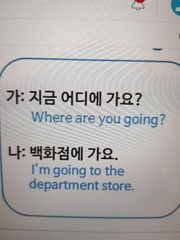
Q: where are you going? A: I am going to the department store. |
|
|
|
시장 |
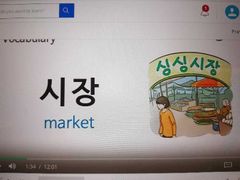
Market |
|
|
|
백화점 |
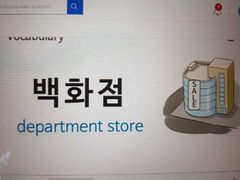
Department store |
|
|
|
슈퍼마켓 |
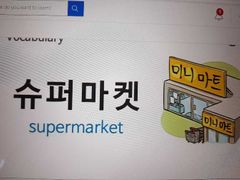
|
|
|
|
편의점 |
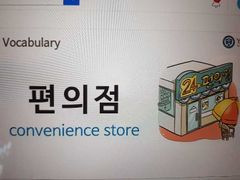
Convenience store |
|
|
|
빵집 |
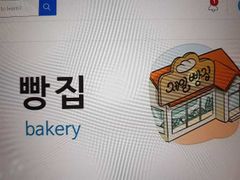
Bakery |
|
|
|
문구점 |
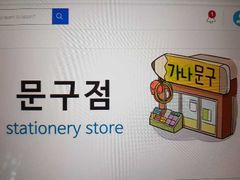
Stationary store |
|
|
|
서점 |

Bookstore |
|
|

N-애 가요 / 와요 |
Suffix-에is a location particle meaning at a location. It is placed after the noun describing the location. In combination with 가요 or 와요 it means going or coming to a location. |
|
|
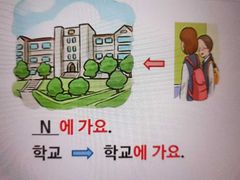
학교에 가요 |
I am going to school |
|
|
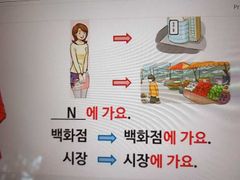
1. 백화점 가요 2. 시정 가요 |
1. I am going to the department store 2. I am going to the market |
|
|
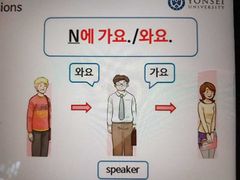
1. 와요 2. 가요 |
When the subject is moving towards the speaker we use 와요 (coming), when the subject is moving away from the speaker we use 가요 (going) |
|
|

친구가 지베 와요 Also: 친구가 우리 집에 와요 |
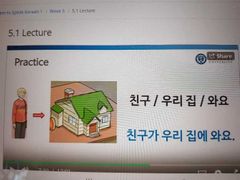
My friend is coming to my house |
|
|

어디에 가요? |
To ask the question: "where are you going?" We attach the location particle suffix -에 to the question word 어디에 and place it before 가요 instead of a noun. |
|
|
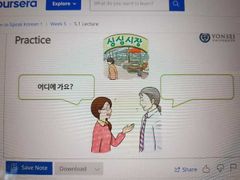
Q: 어디에 가요? |
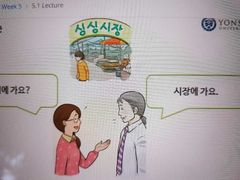
A: 시장에 가요. |
Q: where are you going? A: I am going to the market. |
|

Q: 어디에 가요? |
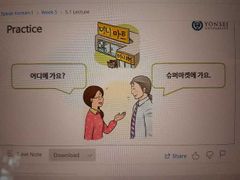
A: 슈퍼마켓에 가요 |
Q: where are you going? A: I am going to the supermarket. |
|
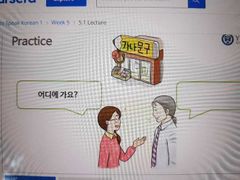
Q: 어디에 가요? |
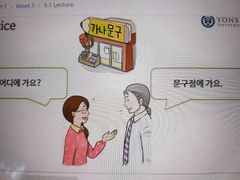
A: 문구점에 가요. |
Q: where are you going? A: I am going to the stationary store. |
|

Q: 어디에 가요? |
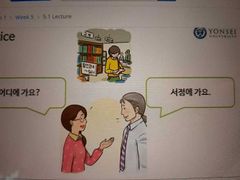
A: 서점에 가요. |
Q: where are you going? A: I am going to the bookstore |
|
|
백화점에 가요. 저도 백화점에 가요. |
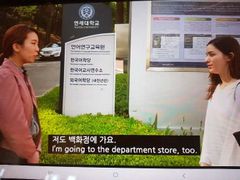
I am going to the department store. I am also going to the department store. |
|
|
|
그래요? 같이 가요? |
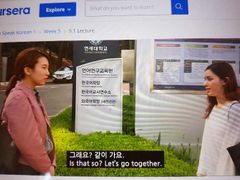
Is that so? Let's go together! |
|
|
|
지금 시간이 있어요? |
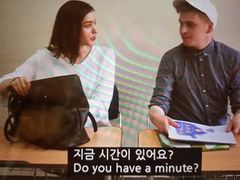
Do you have a minute? |
|
|
|
미안해요, 좀 바빠요. |
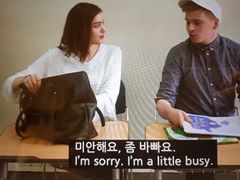
Sorry, I am a little busy. |
|
|
|
무슨 일이 있어요? |
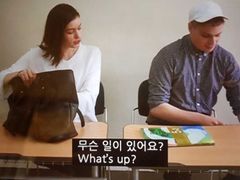
What's the matter? / what's up? / what's wrong? |
|
|
|
지하다 여: 학규 문구점은 지하에 있어요 |
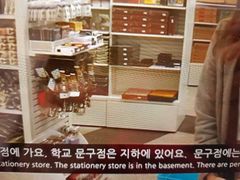
Underground Example: the school's stationary store is in the basement |
|
|
|
문구점에는 볼펜, 연필하고 공책이 있어요. |
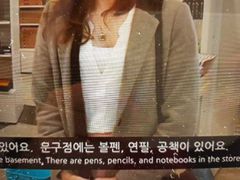
There are pens, pencils and notebooks at the stationary store. |
|
|
|
동대문 시장에 가요 |
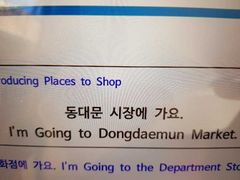
I am going to Dongdaemun market |
|
|
|
옷 가게 |
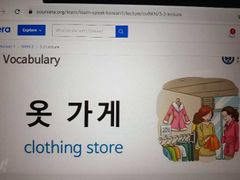
Clothing store |
Pronouncation 옷: ut |
|
|
신발 가게 |

Shoe store |
|
|
|
과일 가게 |

Fruit stand / fruit stall |
|
|
|
꽃 가게 |

Flower shop / florist |
Pronunciation 꽃: kut |
|
|
화장품 가게 |
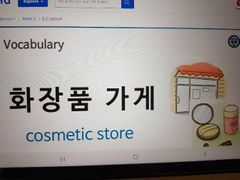
Cosmetic store |
|
|
|
액세서리 가게 |
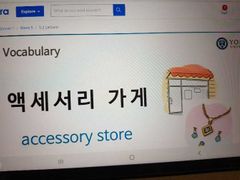
Accessory store |
|
|
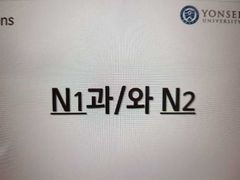
N1 -과 / -와 N2
|
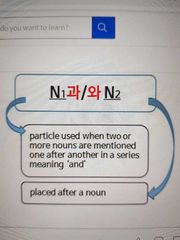
Listing two or more nouns by using the particle 과 (if the preceding noun ends on a consonant) or 와 (if the preceding noun ends on a vowel). Meaning "and" |
Similar to the use pf 하고 |
|
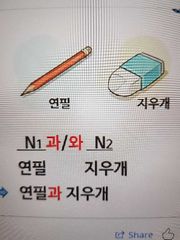
과 / 와 여:1. 연필과 지우개2. 지우개와 연필 |
And Examples:1. Pencil and eraser2. Eraser and pencil (Used in a similar way as 하고 to connect two or more nouns, but is used in written and spoken language, while 하고 is used more often in spoken language) |
과 is used after a consonant, 와 is used after a vowel |
|

옷 가개와 시발가게가 있어요 |
There is a clothing store and a shoe store |
|
|
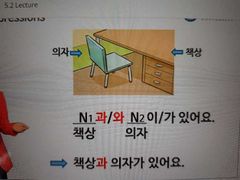
책상과 의자가 있어요 |
There is a desk and a chair |
|
|

가방과 책을 사요 |
I am / he is buying a bag and a book. |
|
|
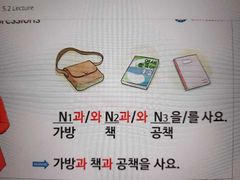
가방과 책과 공책을 사요 |
I am / he is buying a bag and a book and a note book. |
|
|
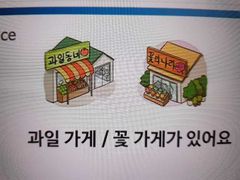
Connect the two nouns 과일 가게 and 꽃 가게 |
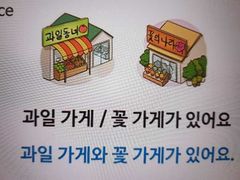
과일 가게와 꽃 가게가 있어요 |
There is a fruit stall and a flower shop |
|
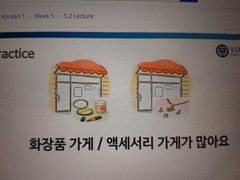
Connect the two nouns 화장품 가게 and 액세서리 가게 |
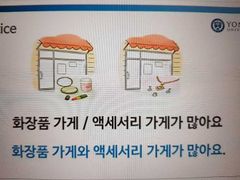
화장품 가게와 액세서리 가게가 많아요 |
There are many / a lot of cosmetic stores and accessory stores |
|
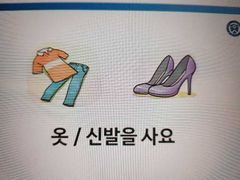
Connect the nouns 옷 and 신발 |
옷과 신발을 사요 |
I am buying clothes and shoes |
|
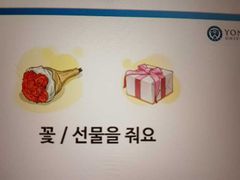
Connect the nouns 꽃 and 산물 |
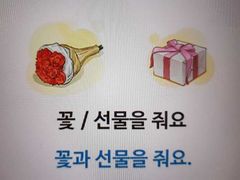
꽃과 선물을 줘요 |
Giving flowers and a present |
|

Q: 방에 무엇이 있어요? |
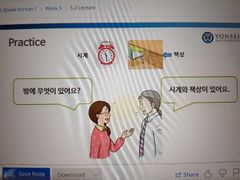
A: 시계와 책상이 있어요 |
Q: what's in the room? A: there's a clock and a desk |
|

Q: 무엇을 사요? |
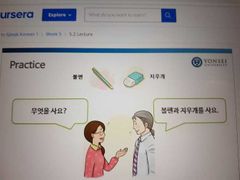
볼펜과 지우개를 사요 |
Q: what are you buying? A: I am buying a pen and an eraser |
|
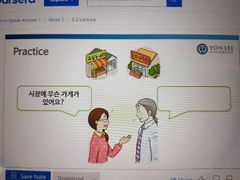
Q: 시장에 무슨 가게가 있어요? |
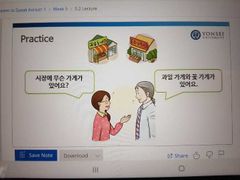
A: 과일 가게와 꽃 가게가 있어요 |
Q: what kind of stores are in/at the market? A: there is a fruit stall and a flower shop |
|
|
Q: 집 근처에 무엇이 있어요? A: 백화점과 공원이 있어요. |
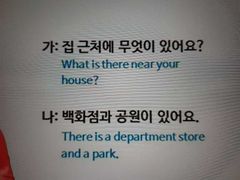
Q: what is near your house? A: There is a department store and a park |
|
|
|
Q: 책상 위에 무엇이 있어요? A: 지오개와 연필이 있어요. |
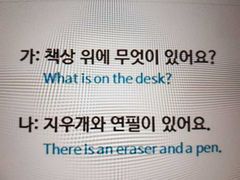
Q: what is in the desk? A: there is an eraser and a pen. |
|
|
|
Q: 어디에 자주 가요? A: 편의점과 서점에 자주 가요. |

Q: where do you tend to go? A: I do to the convenience store and the bookstore often. |
|
|
|
자주 여: 1. 우리는 거기 자주 간다 |
Often Example: we often go there |
|
|
|
Q: 이 근처에 무슨 가게가 있어요? A: 옷 가겡와 과일 가게가 있어요 |
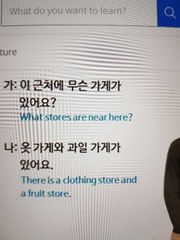
Q: what (kind of) stores are near there? A: there is a clothing and a fruit store |
|
|
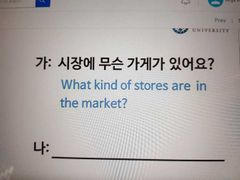
Q: 시장에 무슨 가게가 있어요? |
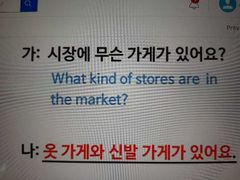
A: 옷 가개와 신발 가개가 있어요 Or: 빵집과 편의점이 있어요. |
A: the are a clothing and a shoe store Or: there is a bakery and a convenience store |
|
|
학생회관 여: 학생회관에 무엇이 있어요? |
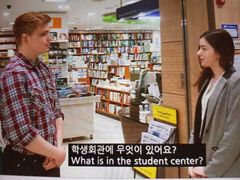
Student centre Example: what is at the student centre? |
|
|
|
식당과 은행이 있어요 |
There is a restaurant and a bank |
|
|
|
Q: 서점도 있어요? A: 네, 서점도 있어요. 첵이 많아요. |
Q: is there also a bookstore? A: yes, there is also a bookstore. It has many books. |
|
|
|
Q: 무슨 름식을 좋아해요? A: 김밥과 라면을 좋아해요. |
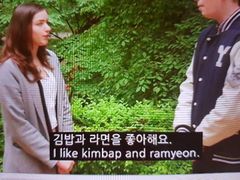
Q: what kind of food do you like? A: I like Kimbap and Ramen. |
|
|
|
시계 |
Watch / clock |
|
|
|
볼펜 |
(Ball) pen |
|
|
|
필통 |
Pencil case |
|
|
|
친구가 딸기와 오렌지를 사요. |
My friend buys strawberries and oranges. |
|
|
|
이 식당은 김치찌개와 비빔밥 맛있어요 |
At this restaurant kimchi stew and bibimbap are delicious |
|
|
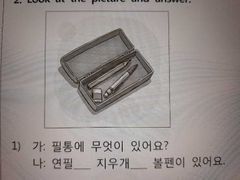
Q: 필통에 무엇이 잇ㅅ어요? |
A: 연필과 지우개와 볼펜이 있어요. |
Q: what is / do you have in the pencil case? A: I have a / there is a pencil, an eraser and a ballpoint pen. |
|
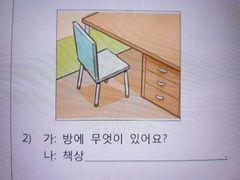
Q: 방에 무섯이 있어요? |
A: 책상과 의자가 있어요 |
Q: what is in the room? A: there is a desk and a chair |
|
|
Q: 무엇을 사고싶어요? A: 인형을 사고싶어요. |
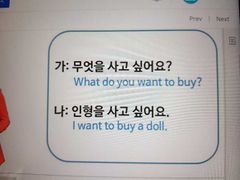
Q: what do you want to buy? A: I want to buy a doll. |
|
|
|
인형 |
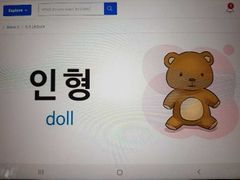
Doll |
|
|
|
상품권 |
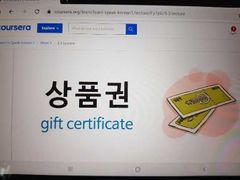
Gift voucher / gift certificate |
|
|
|
꽃다발 |
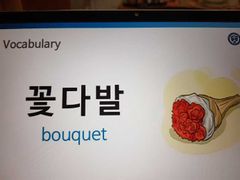
Bouquet (of flowers) |
Pronounced: kutdabal |
|
|
케이크 |
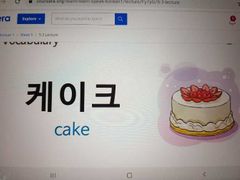
Cake |
|
|
|
넥타이 |
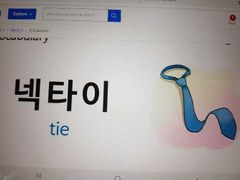
(Neck) tie |
|
|
|
만년필 |
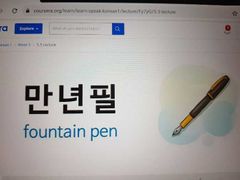
Fountain pen |
|
|
|
장갑 |
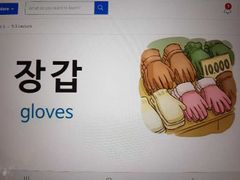
Gloves |
|
|
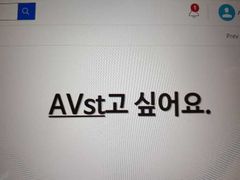
Action Verbstem-고 싶어요 |
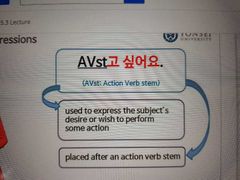
Placed after an action verbstem meaning: want to |
|
|
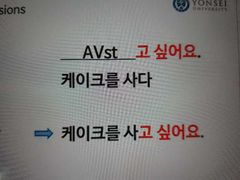
케이크를 사고 싶어요 |
I want to buy some cake |
|
|
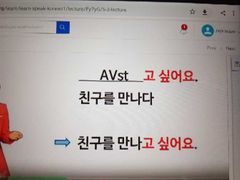
친구를 마나고 싶어요. |
I want to meet my friend/s |
|
|
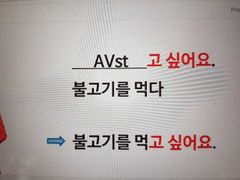
불고기를 먹고 싶어요 |
I want to eat Bulgogi |
|
|
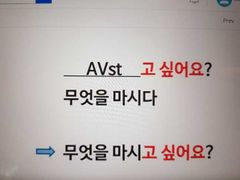
무엇을 마시고 싶어요? |
What do you want to drink? |
|
|
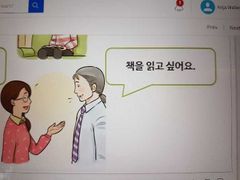
책을 읽고 싶어요 |
I want to read a book |
|
|
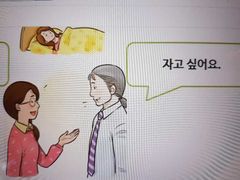
자고 싶어요 |
I want to sleep |
|
|
|
Q: 무엇을 주고 싶어요? A: 만년필을 주고싶어요. |
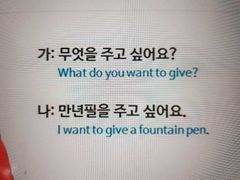
Q: what (present) do you want to give? A: I want to give a fountain pen. |
|
|
|
Q: 무엇을 먹고 싶어요? A: 케이크를 먹고 싶어요. |
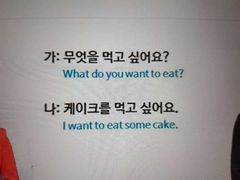
Q: what do you want to eat? A: I want to eat cake. |
|
|
|
Q: 무엇을 사고 싶어요? A: 옷을 사고 싶어요. |
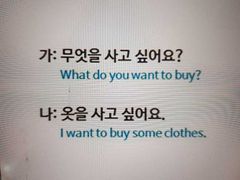
Q: What do you want to buy? A: I want to buy some clothes. |
|
|
|
Q: 어디에 가고 싶어요? A: 제주도에 가고 싶어요. |

Q: where do you want to go? A: I want to go to Jeju island. |
|
|
|
시간 |
Time |
|
|
|
옷 |
Clothes |
|
|
|
Q: 그럼 같이 옷 가게에 갈까요? A: 좋아요. 저도 옷을 사고 싶어요. |
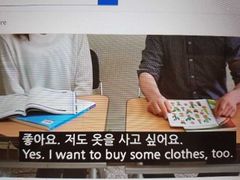
Q: Shall we go to the clothing store together?A: Good. I want to buy clothes, too. |
|
|
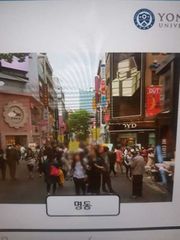
명동 |
Myeongdong (famous shopping district in Seoul) |
|
|
|
Q: 지금 어디에 가요? A: 명동에 가요. Q: 가기에 무슨 가게가 있어요? A: 옷 가게와 화장품 가게가 있어요. Q: 그래요? 저도 가고 싶어요. A: 같이 가요. 명동에는 여러 가지 가게가 많아요. |
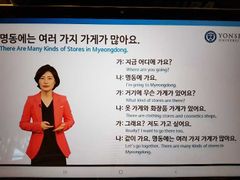
Q: where are you going? A: I'm going to Myeongdong. Q: what kind of stores are there? A: there are clothing stores and cosmetics shops. Q: really? I want to go there too. A: let's go together. There are many kinds of sites in Myeongdong. |
|
|
|
여러 가지 여: 1. 여러 가지 물건 2. 여러가지 음식 |
Various / many (different kinds of) Examples: 1. Various things 2. Many kinds of food |
|
|
|
Q: (name)씨, 지금 어디에 가요? A: 동대문 시장에 가요. Q: 거지에 무슨 가게가 있어요? A: 옷 가게와 액세서리 가게가 있어요. Q: 그래요? 저도 옷을 사고 싶어요. A: 같이 가요. 동대문 시장에는 여러 가지 옷가게가 많아요. |
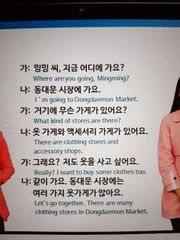
Q: where are you going, (name)? A: I'm going to Dongdaemun market Q: what kind of stores are there? A: the are clothing stores and accessory shops. Q: really? I want to buy dinner clothes too. A: let's go together. There are many clothing sites in Dongdaemun market. |
|
|
|
Q: 지금 어디에 가요? A: 남대문 시장에 가요. Q: 가기에 무슨 가게가 있어요? A: 옷 가게와 신발 가게가 있어요. Q: 그래요? 저도 가고 싶어요. A: 같리 가요. 남대문 시장에는 식당도 많아요. 같이 저녁도 먹어요. |
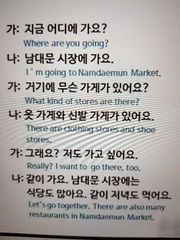
Q: Where are you going now?A: Let's go to Namdaemun Market.Q: What store is there on the way?A: There's a clothing store and a shoe store.Q: Really? I want to go, too.A: Let's go together. There are many restaurants in Namdaemun Market. Let's have dinner together. |
|
|
|
저녁도 |
Evening / dinner |
|
|
|
거기에 |
There |
|
|
|
많아다 여: 많아요 |
A lot / many Example: there is a lot / there are many |
|
|
|
Q: 지금 어디에 사요? A: 인사동에 가요. Q: 거기에 무슨 가게가 있어요? A: 전통 인형 가게와 그림 가게가 있어요. Q: 그래요? 저도 구경하고 싶어요. A: 같이 가요. 인사동에는 전통 찻짐도 있터요. 같이 차도 마셔요. |
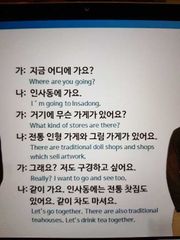
Q: where are you going? A: I am going to Insadong. Q: what kind of stores are there? A: there stew traditional doll shops and shops that sell artwork. Q: really? I want to go and see that as well. A: let's go together. There are also traditional tea houses. Let's drink tea together. |
|
|
|
Q: 어디에 자주 가요? A: 집 근처 시장에 자주 가요. Q: 거기에 무어슨 가게가 많아요? A: 옷 가게와 신발 가게가 많아요. Q: 그 시장은 어때요? A: 물건이 다양해요. 값도 비싸지 않아요. |
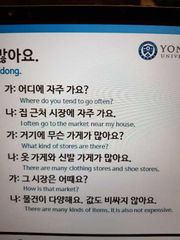
Q: where do you tend to go often? A: I often go to the market near my house. Q: What kind of stores are there? A: there are many clothing stores and shoe stores. Q: how is that market? A: the are many kinds of items. It is also not expensive. |
|
|
|
전통 여: 전통 찻집 |
Tradition Example: traditional teahouse |
|
|
|
Q: (name)씨, 어디에 자주 가요? A: 남대문 시장에 자주 가요. Q: 거기에 무슨 가게가 믾아요? A: 옷 가게와 액세서리 사게가 많아요. Q: 남대문 시장은 어때요? A: 좀 복잡해요. 하지만 여러 가지 가게가 많아요. |
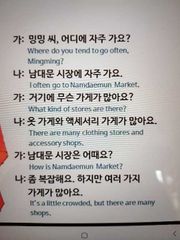
Q: where do you tend to go often? A: I often go to Namdaemun market. Q: what kind of stores are there? A: there are many clothing stores and accessory shops. Q: how is Namdaemun market? A: it's a little crowded, but there are many shops. |
|
|
|
Q: 어디에 자주 가요? A: 학교 앞 가게에 자주 가요. Q: 하교 엎에 무슨 가게가 많아요? A: 웃 가게가 많아요. 식당과 백화점도 있어요. Q: 그 가게 옷이 어때요? A: 예뻐요. 그리고 비싸지 않아요. |
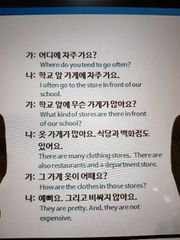
Q: where do you tend to go often? A: I often go to the store in front of our school Q: what kind of sites are in front of our school? A: the are many clothing stores. There are also restaurants and a department store. Q: how are the clothes in those stores? A: they are pretty. And they are not expensive. |
|
|
|
비싸지 여: 값도 비싸지 않아요. |
Expensive Example: it's also not expensive. |
|
|
|
값 여: 값도 비싸지 않아요 |
Value / price / cost Example: it's also not expensive |
|
|
|
근처 여: 집 근처 시장에 자주 가요 |
Near Example: to the market near my house I go often |
|
|
|
예뻐다 여: 예뻐요 |
Pretty Example: it's pretty / they are pretty |
|
|
|
좀 여: 좀 복잡해요 |
Some / a little It's a little crowded |
|
|
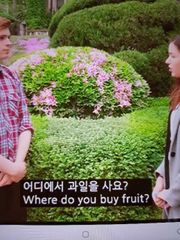
Q: 어디에서 과일을 사요? A: 학교 앞 과일 가게에서 과일을 사요. |
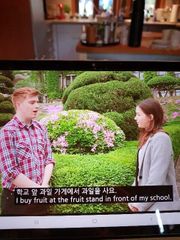
Q: where do you buy fruit? A: I buy fruit at the fruit stand in front of my school. |
|
|

Q: 그 가게가 어때요? A: 과일이 맛있어요. 값도 비싸지 않아요. |

Q: how is that store? A: the fruits are tasty. The prices are also not expensive. |
|
|
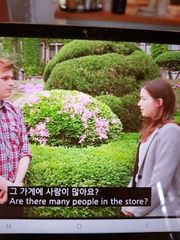
Q: 그가게에 사람이 않아요? A: 네, 사람이 많아요. 하지만 저녁에는 복잡하지 않아요. |
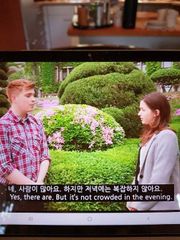
Q: are there many people in that store? A: yea, there are many people. But it is not crowded in the evenings. |
|
|
|
찻집 |
Teahouse |
|
|
|
기림 |
Picture |
|
|
|
생일 선물 |
Birthday gift |
|
|
|
옷 |
Clothes |
|
|
|
화장품 |
Cosmetics |
|
|
|
신발 |
Shoes |
|
|

Q: 백화점에서 무엇을 사요? |
A: 백화점에서 가방을 사요 |
Q: what do you buy at the department store? A: I as m buying a bag at the department store. |
|
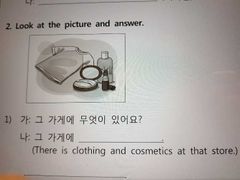
Q: 그 가게에 무엇이 있어요? |
A: 그 가게에 웃과 화장품이 있어요 |
Q: what is available at that store? A: they have clothes and cosmetics. |
|
|
날마다 |
Every day |
|
|
|
필통 |
Pencil case |
|
|
|
장갑 |
Gloves |
|
|
|
인형 |
Doll |
|

